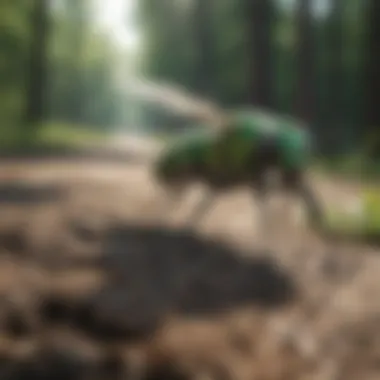Effective Strategies for Emerald Ash Borer Chemical Control


The Emerald Ash Borer (EAB) is an invasive insect species that poses a dire threat to ash trees, wreaking havoc on these majestic flora. Originating from Asia, this beetle displays a metallic green hue and measures from half to one inch in length. Its larvae tunnel beneath the bark of ash trees, ultimately causing their decline and demise. While not entirely discerning in its selection of host trees, the Emerald Ash Borer predominantly infests ash species, leading to devastating consequences in affected regions.
Control Methods and Considerations
In the quest to manage the spread of the Emerald Ash Borer and mitigate its impact, various chemical control methods have been explored. From the application of insecticides to the utilization of biological control agents, each strategy has its own set of efficacy, environmental implications, and considerations. Understanding the nuances of each approach is paramount in devising effective measures to safeguard ash trees from the relentless onslaught of this destructive insect.
Insecticides: A Double-Edged Sword
One of the primary chemical control methods for combating the Emerald Ash Borer involves the targeted use of insecticides. While insecticides can be highly effective in eradicating EAB populations, their application raises concerns regarding environmental repercussions and non-target effects. Thus, a delicate balance must be struck between curbing infestations and minimizing harm to beneficial insects and ecosystems.
Biological Control Agents: Nature's Arsenal
On the other hand, biological control agents present a more environmentally friendly approach to managing Emerald Ash Borer populations. By leveraging natural predators and parasites of the EAB, such as certain species of parasitoid wasps, the infestation levels can be kept in check through biological means. This sustainable approach aligns with principles of integrated pest management and underscores the complex interplay between species in the ecosystem.
Conclusion
Introduction:
Understanding the Emerald Ash Borer:
To comprehend the emerald ash borer is to grasp the magnitude of the threat it poses to ash trees. This insidious beetle tunnels beneath the bark of ash trees, disrupting the tree's ability to transport water and nutrients, ultimately leading to its decline and potential death. The emerald ash borer's lifecycle, feeding habits, and reproductive capabilities all contribute to its rapid spread and devastating impact on ash tree populations. Understanding these key aspects is essential in devising effective control measures to manage and limit the spread of this destructive pest.
Significance of Chemical Control:


The significance of chemical control in addressing the emerald ash borer infestation cannot be overstated. Chemical control methods offer a targeted and efficient means of combatting the insect population while minimizing the impact on non-target species. By utilizing insecticides, biological control agents, and botanical extracts, experts can tailor treatment approaches to suit specific infestation levels and ecosystem conditions. The effectiveness of chemical control in managing the emerald ash borer underscores the importance of continuous research and innovation in developing sustainable pest management strategies.
Chemical Control Methods
In tackling the threat posed by the destructive emerald ash borer, the utilization of chemical control methods emerges as a crucial aspect. These methods play a pivotal role in managing infestations and safeguarding ash trees from significant damage. By exploring insecticides, biological control agents, and botanical extracts, this article sheds light on the efficacy, environmental considerations, and overall impact associated with chemical control strategies.
Insecticides
Systemic Insecticides
Systemic insecticides form a cornerstone in the arsenal against the emerald ash borer invasion. Their key characteristic lies in being absorbed by the tree, circulating within its vascular system to combat the invasive pests effectively. The systemic nature of these insecticides ensures a targeted approach, reaching even the most inaccessible parts of the tree where the emerald ash borer thrives. While systemic insecticides offer a potent and long-lasting solution, their application requires thorough consideration of potential environmental implications and long-term effectiveness.
Contact Insecticides
Contact insecticides provide a different yet equally vital approach to combating the emerald ash borer. Unlike systemic insecticides, contact variants target the pests upon direct contact, offering immediate action against the invasive population. Their key characteristic lies in the rapid knockdown effect, swiftly eliminating emerald ash borers on contact. The unique feature of contact insecticides lies in their ability to deliver swift results, particularly in targeted applications. However, considerations must be made regarding reapplication frequency and any potential impact on non-target organisms.
Residual Insecticides
Residual insecticides present a robust line of defense against the ongoing threat of the emerald ash borer. Their key characteristic lies in their prolonged efficacy post-application, creating a lasting barrier against future infestations. The unique feature of residual insecticides is their ability to offer sustained protection, forming a shield that deters emerald ash borers over an extended period. While highly effective, the use of residual insecticides necessitates careful monitoring of residue levels and potential implications on the surrounding ecosystem.
Biological Control Agents
In addition to insecticides, biological control agents play a vital role in managing emerald ash borer populations. These natural predators, including parasitoid wasps and predatory beetles, offer a sustainable and eco-friendly approach to pest management. The integration of biological control agents serves to establish a balance within the ecosystem, reducing reliance on chemical interventions while promoting natural pest control mechanisms.


Parasitoid Wasps
Parasitoid wasps emerge as key allies in the battle against the emerald ash borer infestation. Their key characteristic lies in the parasitic relationship with the borer larvae, effectively utilizing them as hosts for their own development. The unique feature of parasitoid wasps is their ability to target emerald ash borer populations specifically, offering a tailored solution to combat the invasive species. While beneficial in reducing borer numbers, considerations must be made regarding the potential impact on non-target insects and the need for sustainable release strategies.
Predatory Beetles
Predatory beetles stand out as formidable allies in the quest to control emerald ash borer populations naturally. Their key characteristic lies in the predation of emerald ash borer eggs, larvae, and adults, effectively curbing population growth. The unique feature of predatory beetles is their voracious appetite for emerald ash borers, contributing significantly to population suppression in ash tree habitats. While advantageous in promoting a balanced ecosystem, the introduction of predatory beetles requires careful monitoring to prevent unintended consequences.
Botanical Extracts
Complementing traditional insecticides and biological control agents, botanical extracts offer a natural and sustainable alternative in emerald ash borer management. These plant-derived compounds, with their diverse chemical properties, can serve as potent repellents or toxicants against the invasive pest. The utilization of botanical extracts presents an environmentally friendly approach to pest control, tapping into nature's own defenses to safeguard ash tree populations.
Factors to Consider
Environmental Impact
The Environmental Impact of employing chemical control measures against the Emerald Ash Borer necessitates a thorough examination of potential consequences on ecosystems and wildlife. Systemic insecticides and botanical extracts applied for EAB management can inadvertently impact beneficial insects, pollinators, and other components of the ecological food chain. Addressing these environmental concerns involves conducting in-depth studies on the leaching potential of chemicals into soil and water sources, as well as the persistence of toxic residues in the environment. To mitigate adverse effects, researchers and practitioners must explore eco-friendly alternatives, integrate targeted application strategies, and prioritize conservation efforts to uphold biodiversity and ecosystem resilience amidst pest control activities.
Effectiveness and Long-Term Results
Assessing the Effectiveness and Long-Term Results of chemical control tactics is crucial in evaluating the sustainability and impact of EAB management practices. Monitoring the efficacy of insecticides in eradicating Emerald Ash Borers and suppressing population growth is essential to gauge the success of control programs. Understanding the longevity of control agents on treated trees, as well as their residual effect on pest populations, aids in determining the durability and efficiency of chemical interventions over time. Long-term studies on the adaptability of EAB and the potential development of resistance to chemical treatments further underscore the importance of implementing diverse control strategies and fostering continuous research to combat evolving pest pressures sustainably.
Regulatory Considerations


Navigating the Regulatory Considerations related to chemical control methods for Emerald Ash Borers involves adhering to legislation, guidelines, and protocols governing pesticide usage and environmental protection. Compliance with regulatory frameworks ensures the safe and responsible application of insecticides, biological control agents, and other treatment modalities in EAB management. Understanding the registration requirements, permissible chemical concentrations, and application protocols prescribed by regulatory bodies is essential to mitigate risks to human health, wildlife, and the wider environment. By prioritizing adherence to regulatory standards and fostering collaborations between researchers, practitioners, and regulatory agencies, the implementation of chemical control measures can align with legal mandates and conservation objectives for sustainable pest management outcomes.
Challenges and Limitations
Resistance Development
Resistance development stands as a significant concern within the context of combatting the Emerald Ash Borer. As these destructive insects adapt to chemical treatments over time, the effectiveness of conventional control methods diminishes, posing a considerable challenge to sustainable pest management. Understanding the mechanisms underlying resistance development is essential to devising proactive strategies that can overcome this obstacle. Researchers explore the genetic, behavioral, and ecological factors contributing to resistance, aiming to leverage this knowledge in developing robust and long-lasting control measures.
Non-Target Effects
Examining the Non-Target Effects of chemical control methods is paramount to minimizing unintended ecological consequences. While targeting the Emerald Ash Borer population, pesticides and biological agents may inadvertently harm beneficial insects, pollinators, and other organisms in the ecosystem. Balancing the efficacy of pest control with the preservation of biodiversity demands meticulous consideration of non-target effects. Researchers focus on evaluating the potential risks posed to non-target species, implementing mitigation measures, and refining application techniques to enhance precision and mitigate collateral damage.
Cost-Benefit Analysis
Future Directions
When we focus on Future Directions, we are essentially looking at the cutting-edge advancements and methodologies that can potentially revolutionize the landscape of ash tree protection. By exploring and embracing the latest technologies and management strategies, we pave the way for a more sustainable and effective approach in mitigating the threats posed by the emerald ash borer.
The strategic emphasis on Future Directions within this article elucidates the evolution of pest management practices and highlights the proactive measures necessary to address emerging challenges. Whether through enhanced surveillance techniques, innovative treatment protocols, or novel research avenues, the exploration of Future Directions offers a beacon of hope for the conservation of ash trees and the ecosystems they support.
Emerging Technologies
Emerging Technologies encompass a diverse array of tools and methodologies, ranging from remote sensing and drone technology for early pest detection to precision application systems that optimize the efficiency and efficacy of chemical treatments. By harnessing the power of data analytics, artificial intelligence, and biotechnology, we unlock new avenues for mitigating the impact of invasive species on our natural ecosystems.
Incorporating Emerging Technologies into our arsenal against the emerald ash borer empowers us to adapt and respond swiftly to evolving challenges. By capitalizing on innovation and scientific progress, we can enhance our capacity to safeguard ash trees and forest health for generations to come.
Integrated Pest Management
IPM goes beyond conventional chemical treatments by incorporating biological controls, habitat modifications, and pest monitoring techniques to minimize environmental impacts and maximize effectiveness. By fostering natural predator-prey relationships and enhancing ecosystem resilience, IPM presents a harmonious alternative to widespread chemical interventions.
Implementing Integrated Pest Management in the context of emerald ash borer infestations not only addresses the immediate challenges posed by this invasive species but also promotes biodiversity conservation and sustainable forest management practices. By synergizing diverse control measures, IPM lays the foundation for a balanced and ecologically sound approach to combatting pest threats.







